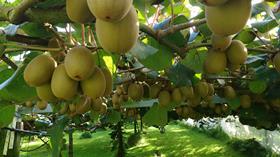
New Zealand headquartered kiwifruit marketer, Zespri, is on alert over a mystery disease sweeping through Italian kiwifruit crops, which has left scientists searching for answers.
The disease, which growers call “moria” or “die-off”, begins in the roots of kiwifruit vines, which blacken and rot. The leaves then wither and drop, leaving fruit exposed to the sun, and the vines dry up and die within two years.
According to a report published by The Guardian, the disease broke out near the Italian city of Verona in 2012 and has affected up to 84 per cent of vines in some areas.
Zespri head of global science innovation, Juliet Ansell, said the kiwifruit marketer was monitoring the situation overseas closely.
“We know optimising soil conditions is important for healthy root growth, and we’ll continue to work with industry so that on-orchard best practice in terms of biosecurity is maintained,” said Ansell.
“Our biosecurity arm, Kiwifruit Vine Health, is continuing to work hard to strengthen biosecurity pathway plans.”
Italy is the world’s second largest kiwifruit producer, growing 555,000 tonnes in 2019. In the same year, New Zealand produced 437,000 tonnes and China grew 2.1m tonnes of the fruit.
Gianni Tacconi, a genomics researcher with Italy’s Council for Agricultural Research and Economics, told The Guardian the disease is fatal for the vines.
“When the symptoms appear, it’s already too late,” said Tacconi. “For kiwi vines, I’d say it’s impossible to recover [from it].”
Despite detailed research into possible causes, including bacteria, fungi, irrigation practices and soil composition, scientists are yet to come up with any definitive answers. However, some researchers believe climate change could be at the heart of the problem. More research is set to be undertaken.
Enjoyed this free article from Asiafruit Magazine and its team of editors? Don’t miss out on even more in-depth analysis, plus all the latest news from the fresh produce business. Subscribe now to Asiafruit Magazine.



